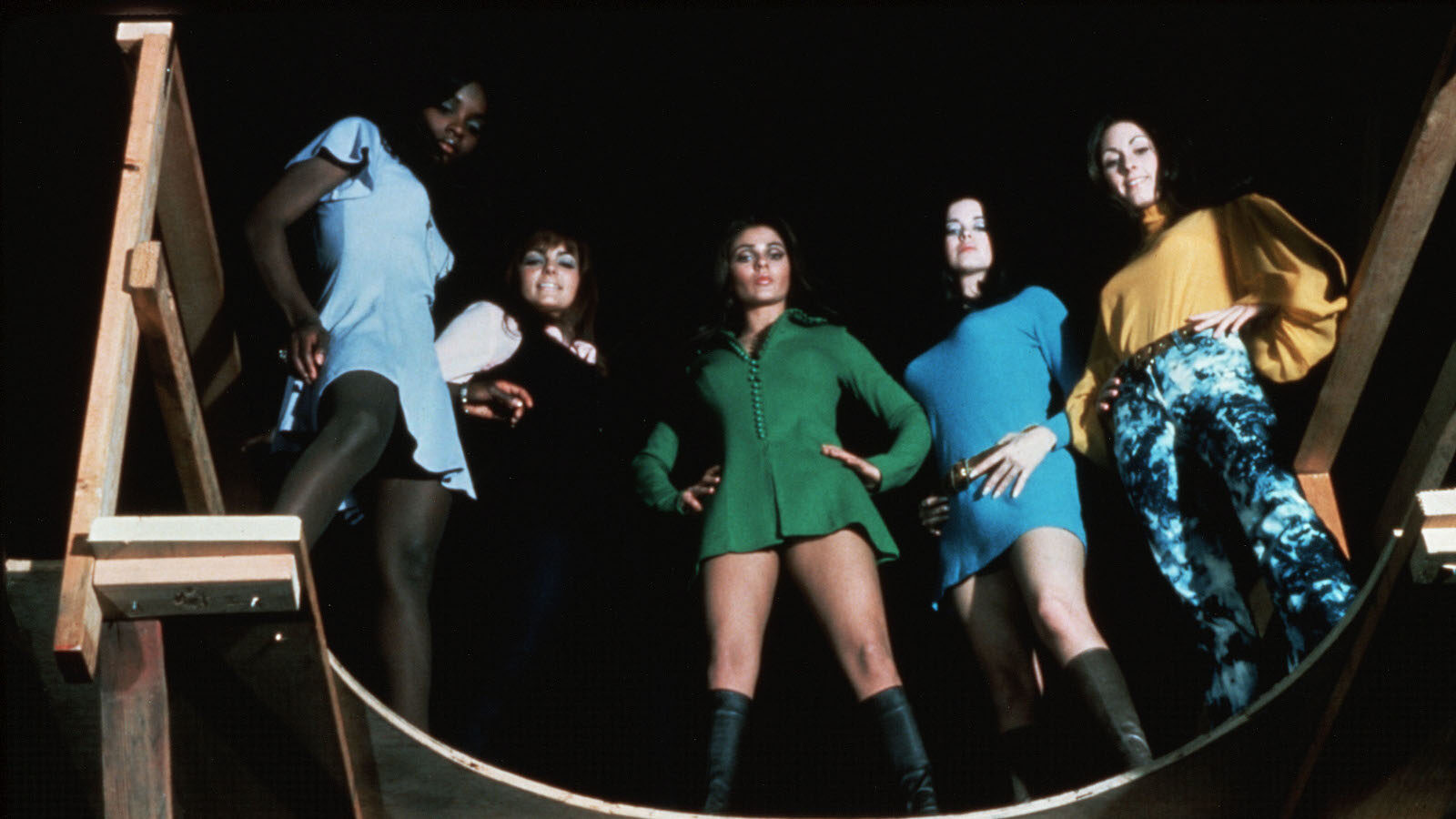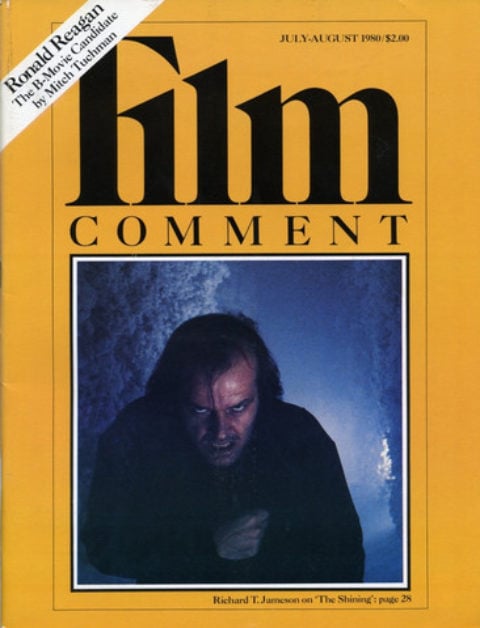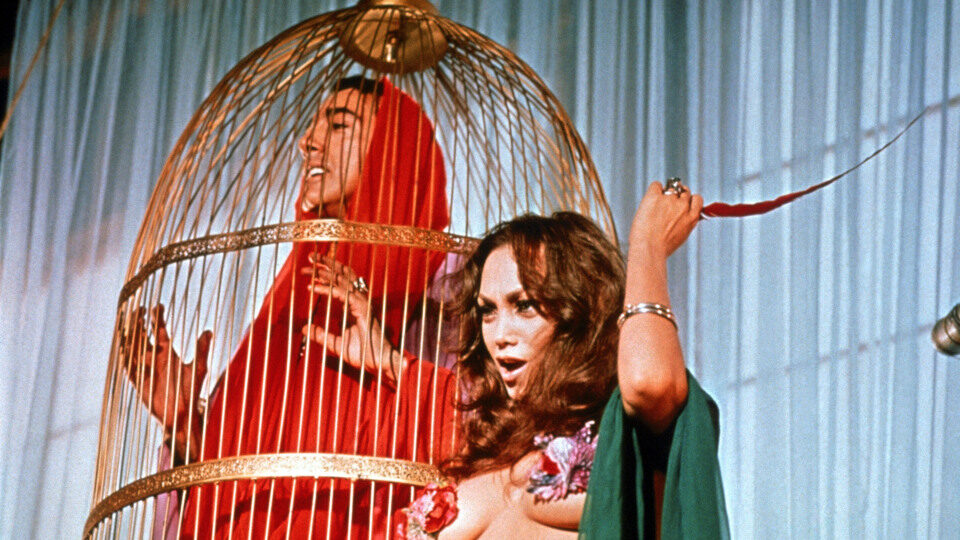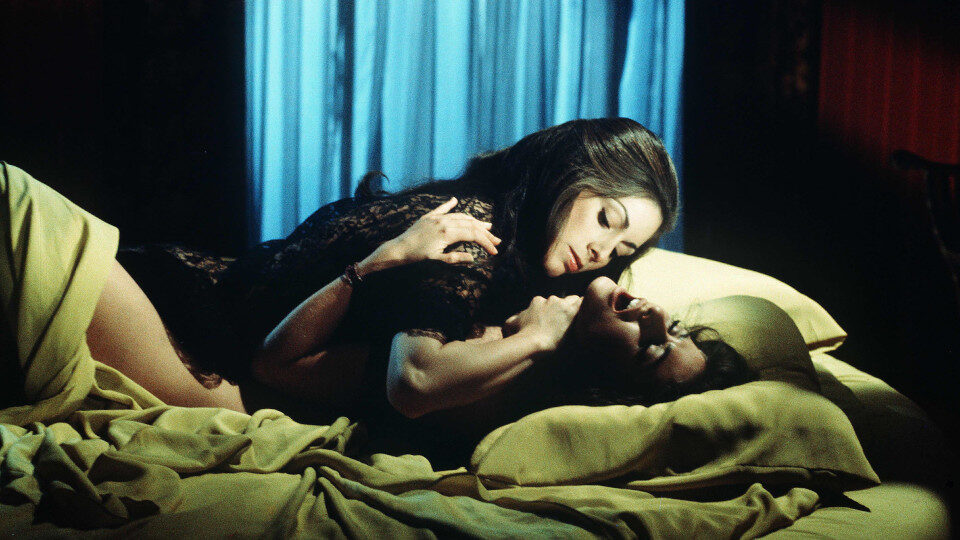
Russ Meyer interviewed by Ed Lowry and Louis Black
A few years ago, you and Roger Ebert were preparing a movie with the Sex Pistols. What happened to it?

The manager, Malcolm McLaren, really overextended himself. We had the sets built and we had it cast. We shot three days and then they folded the show. Now they’re bringing out a film, hopefully with the three minutes I shot, called The Great Rock and Roll Swindle. But they’re lacking some 150,000 pounds to complete it. I know these facts because I’m in litigation with McLaren. I guess Johnny Rotten and I have joined forces.
Did you shoot any footage of the Sex Pistols?
No, but I did a lot of rehearsing with them. Two of them are very intelligent, levelheaded guys—Jones and Cook. Rotten and poor Vicious, who’s no longer here, were absolutely nuts. Both had an intense hatred for McLaren. They would call me up at two in the morning to say unspeakable horrors about him. Rotten definitely had a charisma. Vicious, reputedly and in the script, was fucking his mother. Marianne Faithful was cast for the part. Vicious embraced the sex scenes with his mother, but he objected to us showing them shooting up.
Was McLaren in the film?
No. He wanted to be. He wanted to play the huckster. We had a man who was emulating Mick Jagger. And we had Darth Vader, who was Little John, the chauffeur. The working title was Who Killed Bambi? The script was like A Hard Day’s Night, but more on the order of Beyond the Valley of the Dolls. Instead of four girls, I had four boys. It was about this supposedly aging rock star who was prone to go out into the Queen’s Reserve, shoot a deer, and then give it to the poor. He was dressed in livery and had a convertible Rolls Royce. This Mick Jagger character used a crossbow. We went out to a game reserve and were permitted to kill a small deer, because they multiply so. Anyway, they strap the deer to the hood of the Rolls, and it careens through the countryside. And finally the Jagger character says, “Stop here. It looks like those folks over there could stand a square meal.” So Darth Vader runs over with the deer on his shoulder and throws it on the porch. And a pretty little girl comes out as they drive away and says, “Look, Mommy. Someone’s killed Bambi.”
And at the end of the film she would have appeared again, when Johnny Rotten is trying to emulate Mick Jagger, dressed like him and in makeup. There’s a big rock concert, and she comes forward and at the last moment we see her raise a magnum pistol—a twelve-year old girl—and murder Johnny Rotten, saying, “That’s for Bambi.” Too bad it couldn’t have been made. Probably Vicious would still be living.
What kind of budget did you have on the film?
They never really knew, because McLaren had no conception of what it would cost. We did some eight versions of the script. And then, when they sat down and figured out the shooting days, they said, “What are you doing here? This is too complicated.” So I’d say, “Well, take this out or take that out.” And they’d say, “Oh, no. You can’t do that. You’ll destroy it.”
The conception from the beginning was based on a lack of knowledge. And I have to include myself in that. Originally McLaren had committed no more than 150,000 pounds, with no expense for the Sex Pistols, who wanted a big salary, of course. We just couldn’t do one-quarter of the film as it was conceived. Then the Sex Pistols got hot, so McLaren got Warners to advance another $300,000 and then 20th Century-Fox in England put up another sum of money. Together he got what appeared to be about $1 million. But the budget was like $1.7 million. Everyone was pulling their hair. And then, I understand, Princess Grace got involved in it. She despises me, and she’s an important stockholder at Fox. She was going to pull out all support of Fox in Europe.
Anyway we cast the picture. We literally built every set on stages, shot three days, and then McLaren blew the whistle. He realized, I would guess, that the picture couldn’t be made. But to get in that situation where you’re just the director and not the producer where you can call the shots—it’s a very frustrating experience. McLaren was sincere. He was really a zealot. He had fire in his eyes. But he was unaware of the Sex Pistols’ potential. I think if we’d made the film, they’d have been an important commodity in the States. But instead he determined that he would bring them over and that the young people in the States would assume the same attitude that the young people in England had.
The Guinness Book of World Records called me to confirm something about a month ago: Vixen has the record for the longest run at a drive-in of any film ever made. It played fifty-four weeks in Aurora, Illinois, and that town has a population of around 17,000 people. They saw it many times.
What was it about Vixen that made it work so well? Why did it take off like it did?
Well I suppose that in a sense it was so frank for its time. And a lot of it had to be attributed to Erica Gavin. She had a quality that also appealed to women. And women came in great numbers.
Where did you find Erica Gavin?
She was a stripper. I didn’t find her. Bravely I went up to the location for Vixen without a leading lady and left a couple of my henchmen to try to find somebody. It’s always difficult. But Erica had a curious quality about her. She didn’t have the greatest body, you know. She didn’t have the up-thrust breasts like the others.
Where is she now?
She’s running a boutique in Los Angeles. She’s no longer the zaftig, super-abundant girl we knew. She’s very slim now.
Did you see her in Caged Heat?
Yes I did. She did very well. It was an excellent film. [Jonathan] Demme is a fine filmmaker. I don’t know what the results will be in our time of these kinds of sex farces. So far the numbers are good. But you wonder if the days of really making big money, like with Vixen…
If this is all past?
Well, I won’t say that. If you make it for a price, you can make a lot of money. But being able to pull off a Deep Throat or a Vixen…Of course the answer doesn’t lie in spending huge sums of money. You waste your time and your money in pumping too much into exploitation. It’s an example of diminishing return: dollar spent/dollar earned.
Ebert tells the story that one-third of the footage of Cherry, Harry and Raquel was lost by the lab.
Ebert was out of it when he put that down on paper. He was wrong. It’s not so. What happened was one of the leading ladies couldn’t stand the rigors of Panamint (spelled ‘Panament’ in the article as well) Valley [the location of the film]. She had a couple of Pomeranians, and she would lock them inside all day, and they would just devastate the room. We had a real redneck hotel owner, who was drunk all the time—like Chill Wills, only fatter—and he’d yell about her “goddam dogs.” She took such offense—the very idea this man would object to her dogs using the rug. Finally about two days before we finished, she said, “I’ve had it. I’m going home.”
It was good. The picture’s better because of her leaving. We had to really reach for another ending. She went and you just never saw her again. The picture is the most successful film I have on cable television—or hotel-vision—because you never have to come in at the beginning. It doesn’t matter. It could be a loop.
We also had a great put-on at the end of Cherry, Harry and Raquel about the evils of marijuana. It was so tongue-in-cheek, but people would say, “You’re not really serious.” We had this corny Mexican guitar, a torn fence, and a deserted road. What does it all mean?

Beyond The Valley Of The Dolls - 1970
Did you have problems at 20th Century-Fox?
No. No problems at all. They kept worrying about how long the picture would be, because Ebert writes so much description, and they thought they had like an Apocalypse Now. We had one sequence which would have been good. It dealt with a man named Mr. Fructman, who was supposedly the head of Ajax Studio, in which he chased and then assaulted a young lady in a suite of offices—one of the girls. And [Richard] Zanuck, as he put it, said, “I think we’re going to get some bad laughs there.” He was very concerned about his own image. Maybe it struck too close to home. But we had enough film, so they said, “That’s it. Blow the whistle.”
I later learned that Zanuck was telling people that he hated Beyond the Valley of the Dolls, he wished it were never made, that he was embarrassed by it and so on. At the time, of course, I got notes saying, “Good show. Glad to see your red Cadillac on the lot on Sunday. I know you’re working. Press on.” It’s so treacherous.
Was it a surprise to you that it took off as well as it did?
It didn’t take off that well. It’s become a cult film. They just stopped distribution. It’s a shame because it could almost be a Rocky Horror kind of thing if they would get out and market it. It could have been a much bigger hit if I had distributed it. But that wasn’t permitted.
It was still one of the biggest moneymakers of the year.
Oh, it was. Sure. But it could have made twice or three times that much money. It could do it now. Fox didn’t know how to market the film. For one thing, when they saw it, the guy doing the distributing, who I alienated for the rest of my life, says, “All right, I’m gonna go 50 theaters multiple,” you know. And I said, “No, you can’t. This film needs word of mouth. All my films need word of mouth. We have to play in one theater on the boulevard.” So he said, “Well there are no theaters available.” And Zanuck, who was in the room—you know a lot of things about him I found very admirable—he just got up and said, “buy a theater.” And he walked out of the room.
BVD made money, but it didn’t make anywhere near the money it could have made. If you look in Variety’s report of grosses, I’ve got four films in the top 100 grossing films of all times: number one is Supervixens, number two is Vixen, number three is Cherry, Harry and Raquel and number four is Beyond The Valley Of The Dolls. Cherry, Harry and Raquel has made more than BVD. The potential that exists for that film, even in mid- night shows, is phenomenal. They don’t want to bother. Nothing will happen with that film because they will not make any more prints. The prints you have to look at now are in shit condition.
I tried to approach them—and I’m glad it didn’t work now. I thought I would cut it to an R. But I will not cut any more films to an R. They agreed to let me have it, but we’d have to pay all the expenses. I’d have to order and pay for all the prints, plus the advertising. And they wanted sixty percent. It just was not feasible. So I’m glad it didn’t work.
I wanted to use Erica Gavin in a small part, and I had to approach the casting department of 20th Century-Fox. They’re always encountering you as you walk down those hallowed halls. Every studio boss had his group of yes-men. Zanuck certainly had his, though some of them I admired very much. The casting director met me in the hall and said, “Why are you so insistent on using Erica Gavin in the film.”
And I said, “Well I think she herself represents a number of important ticket buys”—on that level, you know. And he said, “Yeah, but she won’t swing.” That’s the old Hollywood, you know.
And I said, “No, she’s got something about fooling around.” “In fact,” he said, “none of the girls are particularly cooperative.”
Zanuck took me with him when he went to Warners. There were two executive vice-presidents—Zanuck and [John] Calley—both in charge of production. And what happened was a major conflict. It looked for a while like Zanuck was gonna make it. But then Calley had a success with a picture called Klute.
They had advanced us $50,000 and we hired a guy named Jerome Kilty, who wrote Dear Liar, to work up a script on cryogenics—you know, the introduction of nitrogen into the blood to preserve the body in a suspended state. Disney supposedly liked that: when they could cure what was wrong with him—zap, he’d be back.
Well, we had a fantastic script about a guy—someone like Belmondo—who’s a criminal about to be executed, guillotined on the island of Guadeloupe. John Carradine is the jailer. So they fly the executed man’s body on a Lear jet with the nitrogen and all these pipes, to this Dr. DeBakey-type. And they revive his severed head, like in Donovan’s Brain, only the head has a tumor they don’t know about.
But the experiment is to go further. They take all parts of the body and give them to Vietnam veterans. But the brain controls the members, and all these guys commit suicide. There’s a bank guard whose leg is controlled by the brain, and this robber comes in and says, “Don’t move or you’re dead.” But the leg struts happily around, so “Blam”—the guy kills the guard.
Each one of these cadavers is picked up by this girl in love with the brain, and they’re brought to this remote airdrome. They get the doctor there by holding his daughter for ransom and he reassembles the evil Belmondo, who then murders him. The tumor is really making him freak out at this point. The intern is the hero. Great script! It’s exciting even to think about it.
What happened?
Zanuck and [David] Brown just left. Zanuck went theoretically with some sort of appendix problem. Brown wasn’t even going to say goodbye. This guy just came by—I had an office and secretaries—and he said, “Clear it out. Get everything out by 2:00.” One day you’ve got $50,000 and the next…You never hear “boo” from these guys again.
Brown is the kind of guy…you remember The Red Badge of Courage? This thin Colonel Sanders-type on a white charger would ride up and down the line before the battle and ask the troops, “How’s the wife and kids?” Then he’d gallop off to the rear to have a big grits breakfast. And the guys would mount up, and two minutes later they were all dead. That’s Brown. Everything’s a flowery “Well, how are you? You’ve made a classic.” Then they go to court with me and say, “We weren’t glad to do it.” The treachery is awesome.
Oh it’s a great experience. You go there and you’re turned loose with a lot of money: You can go to the private dining room and order anything you want. If your luggage is broken they’ll repair it at enormous cost to the stockholders. They’ll give you a couple of cars. “Does your (typo from the article: “you”) old lady want a car? What would she like? A Corvette?” I say, “Well, I have a car.” And they say, “That’s OK. Take another one.” It’s great.
I made the mistake of acquiring a big fat head while I was there. I was flush with victory from Vixen, Cherry, Harry and Raquel, and BVD. They told me, “You must do The Seven Minutes. You are the spokesperson against the forces of censorship.” And Irving Wallace sits there with this profound look. They gave me $2.7 million for the film, but no tits and ass. The first night in every theater was packed. And the next night: three people. Why? The audience knows.
I had another property I should have done instead. But Brown gave me the blue smoke up my ass. So I did it, and it was a good film. But attaching my name to that film was a bummer. It does a great disservice to everyone concerned.
I really got into things I shouldn’t have done. I made a picture called Blacksnake that had a lot of things wrong with it. It had a skinny leading lady and she was British. All the actors were British. It was a costume movie. Like everything you could possibly do wrong, I did. It was a weak Mandingo. It’s been called Sweet Susie and now it’s called Duchess of Doom.

Beyond The Valley Of The Dolls - 1970
You emphasized the violence rather than the sex.
Well, we thought we were making a picture that the blacks would really love. Now if we had made it about four years before it might have been a blockbuster. But we ended up with a film that blacks and whites both hated. The only place it did good business was in Little Rock. Little Rock’s a great town for me.
What happened to Foxy, the movie you plugged at the end of Blacksnake?
Oh, well. If I’d stayed with the young lady…I just couldn’t picture myself making twenty films starring Edy Williams. It wasn’t all that bad, because out of it came a very good film called Supervixens. But even with Supervixens, people kept asking, “Why did you have to have that bathtub murder,” when really the success of the film was the bathtub scene, since there was so little sex in the picture. After a tour of Ivy League colleges and after showing it in Europe, it was clear to me that in the two weeks before its national release I had to interject some more sex. And I did, fortunately. Otherwise I don’t think it would have performed as well as it did. But it wouldn’t have worked as an R. The audience smells that. You lift a whole sequence out and they won’t come.
Did you cut Supervixens to an R?
Yeah. We saw that version just the other day and it was a real disappointment. There’s no bathtub scene. I wouldn’t do it again.
You say there’s no violence in Beneath the Valley of the Ultravixens?
None whatsoever.
That’s quite a change.
It is. I found that in the picture Up, there was a lot of objection to the violence. I always felt that they would take it in the manner I presented it. That if a man got a double-bitted axe buried in his chest, he could still wrench it out, run 100 yards and kill a giant with a chainsaw. But they just took it very seriously. So what I’ve done is to kind of ape the violence that I’ve had before and it seems to get a good reaction.
Are you pleased with Up?
No. Not particularly. At the time I was fairly pleased, but I see a lot of reasons why it was not as successful as Supervixens.
Did you make your money back on Blacksnake?
I’ve just made my money back on Blacksnake and Up. Up cost almost as much as Ultravixens, simply because I had to do so many inserts and so forth. The cost of additional shooting can be very substantial. You have to consider the escalation of lab costs. I have confidence that pictures will continue to make money for me as long as I wish to make them provided I don’t spend any more than $300,000, which is what I spent on Ultravixens. Because then I think the return becomes a little too nervous-making.
How did you shoot it for $300,000?
You just do everything to scale. You edit it yourself, you co-write it, you co-score it, you’re your own cameraman, producer, director, and you cast the picture. You shoot it in the front room of your house. I bought a house that had a 28-foot ceiling, and we built the sets in the house, because it was scaled in such a way. I wanted to photograph it myself, because it was a kind of umbilical cord, to see what was happening before you said, “Print it.” I wouldn’t do it on the next one. I’ve found a cameraman who I’m inclined to use. He was the camera operator on Barry Lyndon, for John Alcott. He’s very good, an Australian. And he laughs at the same jokes, you know.
How many set-ups can you do in a day?
Well, it depends on how the juices are flowing. Quite a number. I make a lot of cuts because that’s my style and it works well. A lot of the lines were looped. [Francesca] Kitten [Natividad], for example, because of the shit-kicker style, worked with Bob Easton, who is a very good dialect coach. He taught people like Anthony Hopkins, when he was in Magic, to talk like a Yankee. And Laurence Olivier, when he did The Betsy. He worked with her for two or three days and helped her a lot. The black girl we used, June Mack, spoke without any trace of accent, so we hired a girl who had formerly come from Mississippi to dub her voice.
What about the colored blood?
I thought it would ape the violence. It’s just one punch and the guy says, like Horatio Alger, sort of like, “Take that, Jack Dalton.” And that’s the extent of it. The only man that bleeds red is Peterbilt, he’s our redneck—the only straight screw in the show. I mean among the men. The women are all very straight. Kitten plays two roles. She plays Lavonia, who is the lead, who is living with Lamar Shedd, who has this bizarre sexual problem; and she also plays Lola Langusta, with proper explanation and speaks for some ten minutes in Spanish.
With subtitles?
No. We have the man from Smalltown, U.S.A., Stuart Lancaster, who’s done a lot of films for me, who’s the grand old shit-kicker of them all, and he observes, comments, explains. So he’s able to carry on a running narrative, which permits you to avoid subtitles. He’s also involved with Uschi Digard at the end of the picture. He has a fourteen-year old son named Rhett, who’s introduced to sex by Kitten, in what we call the Pecos River—it’s really the Colorado, the reason being it’s too tough a climb down to the Pecos. I don’t think the water runs as warm there either.
So this is a Texas movie?
Definitely. Rio Dio, Texas. Smalltown, U.S.A. Average people, ordinary people. The folks next door. Walk down any street. Who do you meet? Your neighbors.
The character names are wonderful: Eufaula Roop. Flovilla Thatch.
You know where they’re from? The environs of Atlanta. All those names—like Flovilla, Eufaula, and Lavonia—they’re all counties. And Lamar Shedd…well, I took Lamar from Jonathan Winters.
What next?
The Jaws of the Vixen. She never lets go. You get a title—that’s all you need. I’ll have Kitten here and a whole new batch of bosom buddies. We plug it at the end of the film.







